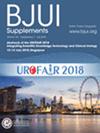Varying the intensity of cystoscopic surveillance for high‐risk non‐muscle‐invasive bladder cancer
IF 3.7
2区 医学
Q1 UROLOGY & NEPHROLOGY
引用次数: 0
Abstract
ObjectivesTo compare the clinical, economic, and health utility outcomes associated with alternative cystoscopic surveillance regimens for high‐risk non‐muscle‐invasive bladder cancer (HRNMIBC).Patients and MethodsWe performed real‐world clinical data‐driven microsimulations of a hypothetical cohort of 100 000 patients diagnosed with HRNMIBC at age 70 years. The cohort was simulated to undergo alternative surveillance regimens recommended by five guidelines, and two hypothetical regimens—surveillance intensity escalation and de‐escalation—which had a surveillance intensity moderately higher and lower, respectively, than the guideline‐recommended regimens. We evaluated the 10‐year cumulative incidence of muscle‐invasive bladder cancer (MIBC), cancer‐specific survival (CSS), overall survival (OS), and cost‐effectiveness from a United States healthcare payer perspective.ResultsThe guideline‐recommended surveillance regimens led to an estimated 10‐year cumulative incidence of MIBC ranging from 11.0% to 11.6%, CSS 95.0% to 95.2%, and OS 69.7% to 69.8%. Surveillance intensity escalation resulted in a 10‐year cumulative incidence of MIBC of 10.5% (95% confidence interval [CI] 10.3–10.7%), CSS of 95.4% (95% CI 95.2–95.5%), and OS of 69.9% (95% CI 69.6–70.1%), vs 11.9% (95% CI 11.7–12.1%), 94.9% (95% CI 94.8–95.1%), and 69.6% (95% CI 69.3–69.9%), respectively, from surveillance intensity de‐escalation. By increasing surveillance intensity, the number‐needed‐to‐treat to prevent one additional MIBC progression over 10 years was ≥80, and ≥257 to avoid one additional cancer‐related mortality. Compared to surveillance intensity de‐escalation, higher‐intensity regimens incurred an incremental cost of ≥$336 000 per incremental quality‐adjusted life year gained, which well exceeded conventional willingness‐to‐pay thresholds, ≥$686 000 per additional MIBC progression prevented, and ≥$2.2 million per additional cancer‐related mortality avoided.ConclusionIn microsimulations testing a wide range of cystoscopic surveillance intensity for patients newly diagnosed with HRNMIBC, moderate surveillance de‐escalation appears associated with an insignificant change in 10‐year OS and furthermore is cost‐effective vs higher‐intensity surveillance regimens. These results suggest that moderate surveillance de‐escalation can reduce costs of care without compromising life expectancy for many patients.改变高风险非肌层浸润性膀胱癌的膀胱镜监测强度
患者和方法 我们对由 10 万名 70 岁确诊为 HRNMIBC 的患者组成的假定队列进行了真实世界临床数据驱动的微观模拟。模拟人群接受了五项指南推荐的替代监测方案,以及两种假定方案--监测强度升级和降级--其监测强度分别比指南推荐的方案略高和略低。我们从美国医疗支付方的角度评估了肌层浸润性膀胱癌(MIBC)的 10 年累积发病率、癌症特异性生存率(CSS)、总生存率(OS)和成本效益。结果指南推荐的监测方案导致的 MIBC 10 年累积发病率估计为 11.0% 到 11.6%,CSS 为 95.0% 到 95.2%,OS 为 69.7% 到 69.8%。监测强度升级后,MIBC 的 10 年累计发病率为 10.5%(95% 置信区间 [CI] 10.3-10.7%),CSS 为 95.4%(95% CI 95.2-95.5%),OS 为 69.9%(95% CI 69.6-70.1%),而监测强度降级后分别为 11.9%(95% CI 11.7-12.1%)、94.9%(95% CI 94.8-95.1%)和 69.6%(95% CI 69.3-69.9%)。通过提高监测强度,在10年内防止多发生一次MIBC进展所需的治疗人数≥80人,避免多发生一次癌症相关死亡所需的治疗人数≥257人。与监测强度降级相比,高强度治疗方案每获得一个增量质量调整生命年的增量成本≥336 000 美元,远高于传统的支付意愿阈值;每预防一次额外的 MIBC 病变进展的增量成本≥686 000 美元;每避免一次额外的癌症相关死亡率的增量成本≥220 万美元。结论在对新诊断为 HRNMIBC 患者的各种膀胱镜监测强度进行微观模拟测试时,适度降低监测强度似乎与 10 年生存率的微小变化有关,而且与高强度监测方案相比具有成本效益。这些结果表明,适度降低监测强度可以降低医疗成本,而不会影响许多患者的预期寿命。
本文章由计算机程序翻译,如有差异,请以英文原文为准。
求助全文
约1分钟内获得全文
求助全文
来源期刊

BJU International
医学-泌尿学与肾脏学
CiteScore
9.10
自引率
4.40%
发文量
262
审稿时长
1 months
期刊介绍:
BJUI is one of the most highly respected medical journals in the world, with a truly international range of published papers and appeal. Every issue gives invaluable practical information in the form of original articles, reviews, comments, surgical education articles, and translational science articles in the field of urology. BJUI employs topical sections, and is in full colour, making it easier to browse or search for something specific.
 求助内容:
求助内容: 应助结果提醒方式:
应助结果提醒方式:


